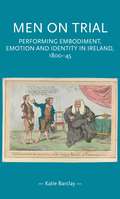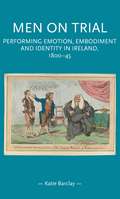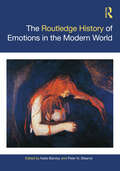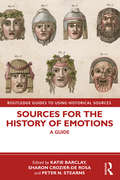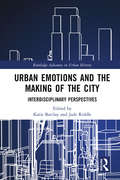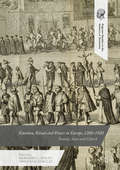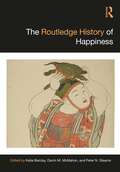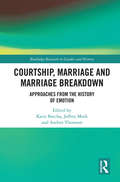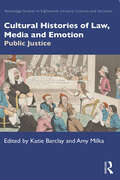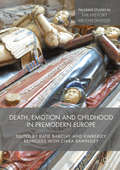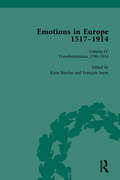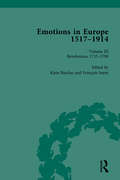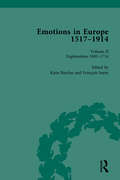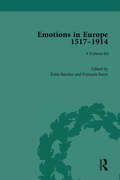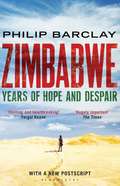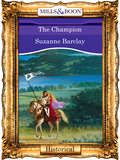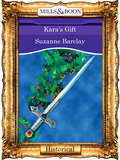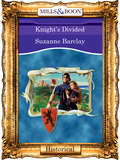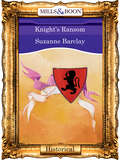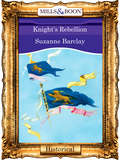- Table View
- List View
Men on trial: Performing emotion, embodiment and identity in Ireland, 1800–45 (Gender in History)
by Katie BarclayMen on trial explores how the Irish perform ‘the self’ within the early nineteenth-century courtroom and its implications for law, society and nation. Drawing on new methodologies from the history of emotion, as well as theories of performativity and performative space, it emphasises that manliness was not simply a cultural ideal, but something practised, felt and embodied. Men on trial explores how gender could be a creative dynamic in productions of power. Targeted at scholars in Irish history, law and gender studies, this book argues that justice was not simply determined through weighing evidence, but through weighing men, their bodies, behaviours, and emotions. Moreover, in a context where the processes of justice were publicised in the press for the nation and the world, manliness and its role in the creation of justice became implicated in the making of national identity.
Men on trial: Performing emotion, embodiment and identity in Ireland, 1800–45 (Gender in History)
by Katie BarclayMen on trial explores how the Irish perform ‘the self’ within the early nineteenth-century courtroom and its implications for law, society and nation. Drawing on new methodologies from the history of emotion, as well as theories of performativity and performative space, it emphasises that manliness was not simply a cultural ideal, but something practised, felt and embodied. Men on trial explores how gender could be a creative dynamic in productions of power. Targeted at scholars in Irish history, law and gender studies, this book argues that justice was not simply determined through weighing evidence, but through weighing men, their bodies, behaviours, and emotions. Moreover, in a context where the processes of justice were publicised in the press for the nation and the world, manliness and its role in the creation of justice became implicated in the making of national identity.
The Routledge History of Emotions in the Modern World (Routledge Histories)
by Katie BarclayThe Routledge History of Emotions in the Modern World brings together a diverse array of scholars to offer an overview of the current and emerging scholarship of emotions in the modern world. Across thirty-six chapters, this work enters the field of emotion from a range of angles. Named emotions – love, anger, fear – highlight how particular categories have been deployed to make sense of feeling and their evolution over time. Geographical perspectives provide access to the historiographies of regions that are less well-covered by English-language sources, opening up global perspectives and new literatures. Key thematic sections are designed to intersect with critical historiographies, demonstrating the value of an emotions perspective to a range of areas. Topical sections direct attention to the role of emotions in relations of power, to intimate lives and histories of place, as products of exchanges across groups, and as deployed by new technologies and medias. The concepts of globalisation and modernity run through the volume, acting as foils for comparison and analytical tools. The Routledge History of Emotions in the Modern World is the perfect resource for all students and scholars interested in the history of emotions across the world from 1700.
Sources for the History of Emotions: A Guide (Routledge Guides to Using Historical Sources)
by Katie BarclayOffering insights on the wide range of sources that are available from across the globe and throughout history for the study of the history of emotions, this book provides students with a handbook for beginning their own research within the field. Divided into three parts, Sources for the History of Emotions begins by giving key starting points into the ethical, methodological and theoretical issues in the field. Part II shows how emotions historians have proved imaginative in their discovering and use of varied materials, considering such sources as rituals, relics and religious rhetoric, prescriptive literature, medicine, science and psychology, and fiction, while Part III offers introductions to some of the big or emerging topics in the field, including embodied emotions, comparative emotions, and intersectionality and emotion. Written by key scholars of emotions history, the book shows readers the ways in which different sources can be used to extract information about the history of emotions, highlighting the kind of data available and how it can be used in a field for which there is no convenient archive of sources. The focused discussion of sources offered in this book, which not only builds on existing research, but encourages further efforts, makes it ideal reading and a key resource for all students of emotions history.
Urban Emotions and the Making of the City: Interdisciplinary Perspectives (Routledge Advances in Urban History)
by Katie BarclayThis book brings together a vibrant interdisciplinary mix of scholars – from anthropology, architecture, art history, film studies, fine art, history, literature, linguistics and urban studies – to explore the role of emotions in the making and remaking of the city. By asking how urban boundaries are produced through and with emotion; how emotional communities form and define themselves through urban space; and how the emotional imaginings of urban spaces impact on histories, identities and communities, the volume advances our understanding of 'urban emotions' into discussions of materiality, power and embodiment across time and space.
Emotion, Ritual and Power in Europe, 1200-1920: Family, State and Church (Palgrave Studies in the History of Emotions)
by Katie Barclay Merridee L. BaileyThis volume spans the fourteenth to nineteenth centuries, across Europe and its empires, and brings together historians, art historians, literary scholars and anthropologists to rethink medieval and early modern ritual. The study of rituals, when it is alert to the emotions which are woven into and through ritual activities, presents an opportunity to explore profoundly important questions about people’s relationships with others, their relationships with the divine, with power dynamics and importantly, with their concept of their own identity. Each chapter in this volume showcases the different approaches, theories and methodologies that can be used to explore emotions in historical rituals, but they all share the goal of answering the question of how emotions act within ritual to inform balances of power in its many and varied forms. Chapter 5 of this book is available open access under a CC BY 4.0 license.
The Routledge History of Happiness (Routledge Histories)
by Katie Barclay Darrin M. McMahon Peter N. StearnsUnmatched in originality, breadth, and scope, The Routledge History of Happiness features chapters that explore the history, anthropology, and psychology of happiness across the globe.Through a chronological approach that ranges from the Classical and Postclassical to the twenty-first century, this volume balances intellectual-history treatments and wider efforts to deal with relevant popular culture and experience, including consumerism. It explores how and why the history of happiness has emerged in recent decades, as well as psychological and social science approaches to happiness, with a history of how relevant psychological research has unfolded. Chapters examine early cultural traditions concerning happiness, including material on Buddhist and Chinese traditions, and how they continue to influence ideas about happiness in the present day. Overall, each section emphasises wide geographical coverage, with particular attention paid to East Asia, Latin America, Europe, Russia, and Africa.The Routledge History of Happiness is of great use to all undergraduates, postgraduates, and scholars interested in the global history of emotions.
Courtship, Marriage and Marriage Breakdown: Approaches from the History of Emotion (Routledge Research in Gender and History #39)
by Katie Barclay Jeffrey Meek Andrea ThomsonThis book explores the history of marriage and marriage-like relationships across five continents from the seventeenth century to the present day. Across fourteen chapters, leading marriage scholars examine how the methodologies from the new history of emotions contribute to our understanding of marriage, seeking to uncover not only personal feeling but also the political and social implications of emotion. They highlight how marriage as an institution has been shaped not just by law and society but also by individual and community choices, desires and emotional values. Importantly, they also emphasize how the history of non-traditional and same-sex relationships and their emotions have long played an important role in determining the nature of marriage as an institution and emotional union. In doing so, this collection allows us to rethink both the past and present of marriage, destabilizing a story of a stable institution and opening it up as a site of contest, debate and feeling.
Courtship, Marriage and Marriage Breakdown: Approaches from the History of Emotion (Routledge Research in Gender and History #39)
by Katie Barclay Jeffrey Meek Andrea ThomsonThis book explores the history of marriage and marriage-like relationships across five continents from the seventeenth century to the present day. Across fourteen chapters, leading marriage scholars examine how the methodologies from the new history of emotions contribute to our understanding of marriage, seeking to uncover not only personal feeling but also the political and social implications of emotion. They highlight how marriage as an institution has been shaped not just by law and society but also by individual and community choices, desires and emotional values. Importantly, they also emphasize how the history of non-traditional and same-sex relationships and their emotions have long played an important role in determining the nature of marriage as an institution and emotional union. In doing so, this collection allows us to rethink both the past and present of marriage, destabilizing a story of a stable institution and opening it up as a site of contest, debate and feeling.
Cultural Histories of Law, Media and Emotion: Public Justice (Routledge Studies in Eighteenth-Century Cultures and Societies)
by Katie Barclay Amy MilkaCultural Histories of Law, Media and Emotion: Public Justice explores how the legal history of long-eighteenth-century Britain has been transformed by the cultural turn, and especially the associated history of emotion.Seeking to reflect on the state of the field, 13 essays by leading and emerging scholars bring cutting-edge research to bear on the intersections between law, print culture and emotion in Britain across the eighteenth and nineteenth centuries. Divided into three sections, this collection explores the ‘public’ as a site of legal sensibility; it demonstrates how the rhetoric of emotion constructed the law in legal practice and in society and culture; and it highlights how approaches from cultural and emotions history have recentred the individual, the biography and the group to explain long-running legal-historical problems. Across this volume, authors evidence how engagements between cultural and legal history have revitalised our understanding of law’s role in eighteenth-century culture and society, not least deepening our understanding of justice as produced with and through the public.This volume is the ideal resource for upper-level undergraduates, postgraduates and scholars interested in the history of emotions as well as the legal history of Britain from the late seventeenth to the nineteenth century.
Death, Emotion and Childhood in Premodern Europe (Palgrave Studies in the History of Childhood)
by Katie Barclay Kimberley Reynolds Ciara RawnsleyThis book draws on original material and approaches from the developing fields of the history of emotions and childhood studies and brings together scholars from history, literature and cultural studies, to reappraise how the early modern world reacted to the deaths of children. Child death was the great equaliser of the early modern period, affecting people of all ages and conditions. It is well recognised that the deaths of children struck at the heart of early modern families, yet less known is the variety of ways that not only parents, but siblings, communities and even nations, responded to childhood death. The contributors to this volume ask what emotional responses to child death tell us about childhood and the place of children in society. Placing children and their voices at the heart of this investigation, they track how emotional norms, values, and practices shifted across the fifteenth to nineteenth centuries through different religious, legal and national traditions. This collection demonstrates that child death was not just a family matter, but integral to how communities and societies defined themselves. Chapter 5 of this book is available open access under a CC BY 4.0 license at link.springer.com.
Urban Emotions and the Making of the City: Interdisciplinary Perspectives (Routledge Advances in Urban History)
by Katie Barclay Jade RiddleThis book brings together a vibrant interdisciplinary mix of scholars – from anthropology, architecture, art history, film studies, fine art, history, literature, linguistics and urban studies – to explore the role of emotions in the making and remaking of the city. By asking how urban boundaries are produced through and with emotion; how emotional communities form and define themselves through urban space; and how the emotional imaginings of urban spaces impact on histories, identities and communities, the volume advances our understanding of 'urban emotions' into discussions of materiality, power and embodiment across time and space.
Sources for the History of Emotions: A Guide (Routledge Guides to Using Historical Sources)
by Katie Barclay Sharon Crozier-De Rosa Peter N. StearnsOffering insights on the wide range of sources that are available from across the globe and throughout history for the study of the history of emotions, this book provides students with a handbook for beginning their own research within the field. Divided into three parts, Sources for the History of Emotions begins by giving key starting points into the ethical, methodological and theoretical issues in the field. Part II shows how emotions historians have proved imaginative in their discovering and use of varied materials, considering such sources as rituals, relics and religious rhetoric, prescriptive literature, medicine, science and psychology, and fiction, while Part III offers introductions to some of the big or emerging topics in the field, including embodied emotions, comparative emotions, and intersectionality and emotion. Written by key scholars of emotions history, the book shows readers the ways in which different sources can be used to extract information about the history of emotions, highlighting the kind of data available and how it can be used in a field for which there is no convenient archive of sources. The focused discussion of sources offered in this book, which not only builds on existing research, but encourages further efforts, makes it ideal reading and a key resource for all students of emotions history.
Emotions in Europe, 1517-1914: Volume IV: Transformations, 1789-1914
by Katie Barclay François SoyerThis volume of primary sources focuses on the history of emotions in Europe and its empires between 1789 and 1914. The study ends with WW1, by which point psychology and modern frameworks for the self had become standard knowledge. The study examines the subjects of the self, family and community, religion, politics and law, science and philosophy, and art and culture. Sources include letters, diaries, legal papers, institutional records, newspapers, science and philosophical writings, literature and art from a diversity of voices and perspectives. Accompanied by extensive editorial commentary, this collection will be of great interest to students of history and literature.
Emotions in Europe, 1517-1914: Volume I: Reformations,1517-1602
by Katie Barclay François SoyerThis volume of primary sources focuses on the history of emotions in Europe and its empires between 1517 and 1602. The Reformation in 1517 was a key transformative moment in European history that required people to rethink the self, belief, and scientific knowledges – all of which shaped and were shaped by emotion. The study examines the subjects of the self, family and community, religion, politics and law, science and philosophy, and art and culture. Sources include letters, diaries, legal papers, institutional records, newspapers, science and philosophical writings, literature and art from a diversity of voices and perspectives. Accompanied by extensive editorial commentary, this collection will be of great interest to students of history and literature.
Emotions in Europe, 1517-1914: Volume III: Revolutions, 1714-1789
by Katie Barclay François SoyerThis volume of primary sources focuses on the history of emotions in Europe and its empires between 1714 and 1789. The study examines the subjects of the self, family and community, religion, politics and law, science and philosophy, and art and culture. Sources include letters, diaries, legal papers, institutional records, newspapers, science and philosophical writings, literature and art from a diversity of voices and perspectives. Accompanied by extensive editorial commentary, this collection will be of great interest to students of history and literature.
Emotions in Europe, 1517-1914: Volume II: Explorations, 1602-1714
by Katie Barclay François SoyerThis volume of primary sources focuses on the history of emotions in Europe and its empires between 1602 and 1714. The study examines the subjects of the self, family and community, religion, politics and law, science and philosophy, and art and culture. Sources include letters, diaries, legal papers, institutional records, newspapers, science and philosophical writings, literature and art from a diversity of voices and perspectives. Accompanied by extensive editorial commentary, this collection will be of great interest to students of history and literature.
Emotions in Europe, 1517-1914
by Katie Barclay François SoyerThis four-volume collection of primary sources focuses on the history of emotions in Europe and its empires between 1517 and 1914. Arranged chronologically, each volume examines the subjects of the self, family and community, religion, politics and law, science and philosophy, and art and culture. The collection begins with the Reformation in 1517 as a key transformative moment in European history that required people to rethink the self, belief, and scientific knowledges – all of which shaped and were shaped by emotion. It ends with WW1, by which point psychology and modern frameworks for the self had become standard knowledges. In between, ideas and practices of emotion were not static, and part of the history charted across these volumes is the making of a new vocabulary for emotions and the self. Sources include letters, diaries, legal papers, institutional records, newspapers, science and philosophical writings, literature and art from a diversity of voices and perspectives. Accompanied by extensive editorial commentary, this collection will be of great interest to students of history and literature.
The Routledge History of Emotions in the Modern World (Routledge Histories)
by Katie Barclay Peter N. StearnsThe Routledge History of Emotions in the Modern World brings together a diverse array of scholars to offer an overview of the current and emerging scholarship of emotions in the modern world. Across thirty-six chapters, this work enters the field of emotion from a range of angles. Named emotions – love, anger, fear – highlight how particular categories have been deployed to make sense of feeling and their evolution over time. Geographical perspectives provide access to the historiographies of regions that are less well-covered by English-language sources, opening up global perspectives and new literatures. Key thematic sections are designed to intersect with critical historiographies, demonstrating the value of an emotions perspective to a range of areas. Topical sections direct attention to the role of emotions in relations of power, to intimate lives and histories of place, as products of exchanges across groups, and as deployed by new technologies and medias. The concepts of globalisation and modernity run through the volume, acting as foils for comparison and analytical tools. The Routledge History of Emotions in the Modern World is the perfect resource for all students and scholars interested in the history of emotions across the world from 1700.
Zimbabwe: Years of Hope and Despair
by Philip BarclayZimbabwe is a country both blessed and cursed. British diplomat Philip Barclay witnessed the downfall of what used to be Africa's finest country, culminating in the tumultuous events of 2008 when Zimbabwe's people voted against Robert Mugabe. But their desire for change was denied as vicious squads of indoctrinated youths loyal to the ageing dictator launched a campaign of murder, rape and destruction. In the wake of such terror, the economy and public services collapsed, leading to widespread poverty and epidemics of diseases that Zimbabwe had not seen in living memory.This electrifying account records the violent excesses of a hated clique prepared to do anything to cling to power. It is also a personal story of the extraordinary resilience of Zimbabwe's people.
The Champion (Mills And Boon Vintage 90s Modern Ser.)
by Suzanne BarclayKNIGHTS OF THE BLACK ROSE AS THE MYSTERY UNFOLDED, SO DID THEIR LOVE… .
Kara's Gift (Mills And Boon Vintage 90s Modern Ser.)
by Suzanne BarclayA pagan healer falls in love with the Christian knight who is destined to save her dying clan.
Knights Divided (Mills And Boon Vintage 90s Modern Ser.)
by Suzanne BarclayThough Emmeline Spencer captured Jamie Harcourt as her prisoner, the rogue adventurer stole kisses from her that were sweet beyond her wildest imagining.
Knight's Ransom (The\sommerville Brothers Ser. #335)
by Suzanne BarclayKIDNAPPED In a heartbeat, Catherine Sommerville's world had changed, transforming her from a cosseted heiress to a prize held for ransom by a battle-scarred knight. Reason demanded that she despise Gervase St. Juste, but her soul whispered that they had been born beneath the same star… .
Knight's Rebellion (Mills And Boon Vintage 90s Modern Ser. #391)
by Suzanne Barclay'Twas Said That The Sommervilles Loved Only Once Yet Alys Sommerville was no heir to this legacy of passion, for the Fates had sent her along a very different road. One that led straight into the arms of Gowain FitzWarren, the leader of a desperate rebel band…
